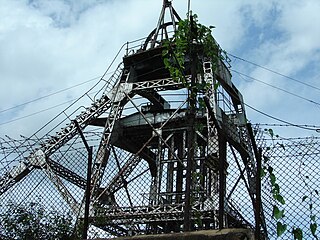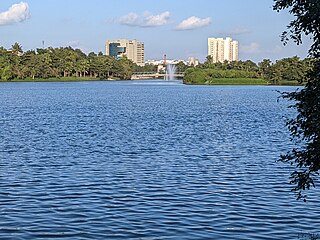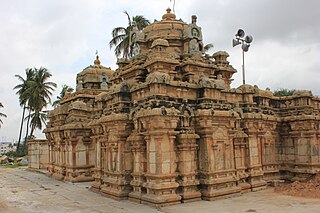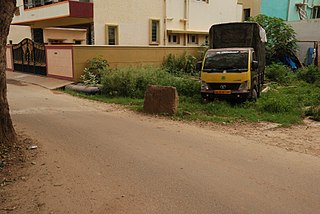
Shahaji Bhonsale was a 17th century Indian military leader who served the Ahmadnagar Sultanate, the Bijapur Sultanate, and the Mughal Empire at various points in his career. As a member of the Bhonsle dynasty, Shahaji inherited the Pune and Supe jagirs (fiefs) from his father Maloji, who previously served the Ahmadnagar Sultanate. During the Mughal invasion of the Deccan, Shahaji joined the Mughal forces and served under Emperor Shah Jahan for a short period. After being deprived of his jagirs, he defected to the Bijapur Sultanate in 1632 and regained control over Pune and Supe. In 1638, he received the jagir of Bangalore after Bijapur's invasion of Kempe Gowda III's territories. Afterwards, he became the chief general of Bijapur and oversaw its expansion.

Kolar Gold Fields (K.G.F.) is a mining region in K.G.F. taluk (township), Kolar district, Karnataka, India. It is headquartered in Robertsonpet, where employees of Bharat Gold Mines Limited (BGML) and BEML Limited and their families live. K.G.F. is about 30 kilometres (19 mi) from Kolar, 100 kilometres (62 mi) from Bengaluru, capital of Karnataka. Over a century, the town has been known for gold mining. The mine closed on 28 February 2001 due to a fall in gold prices, despite gold still being present there. One of India's first power-generation units was built in 1889 to support mining operations. The mine complex hosted some particle physics experiments between the 1960s and 1992.

Bangalore is the capital city of the state of Karnataka. Bangalore, as a city, was founded by Kempe Gowda I, who built a mud fort at the site in 1537. But the earliest evidence for the existence of a place called Bangalore dates back to c. 890.

Magadi is a town and taluk located in Bengaluru South district, Karnataka, India.

Malleshwaram is a northwest neighborhood and one of the zones of Bruhat Bengaluru Mahanagara Palike in Bengaluru, India. It was planned in 1889 after the great plague of 1898, developed as a suburb in 1892 and handed over to the city municipality in 1895. As per the 1878 Survey of India map, the area came under the village of Ranganatha Palya and was later named after the Kadu Malleshwara Temple. The neighbourhood houses many offices, one them being World Trade Center Bengaluru. It has two shopping malls, Mantri Square and Orion Mall. As an education hub,it houses the education boards of the state KSEEB and PU boards,Mysore Education Society and Indian Institute of Science.

Vyankojirajah Bhonsle or Ekojirajah I Bhonsle was the younger half-brother of Chhatrapati Shivaji Maharaj and founder of Maratha rule in Thanjavur in modern day Tamil Nadu. He was the progenitor of the junior branch of the Bhonsle family which ruled Thanjavur until the formal annexation of the kingdom by the British East India Company in 1855.
Shivaji was the founder of the Maratha Empire in the Indian subcontinent. This article describes Shivaji's life from his birth until the age of 19 years (1630–1649).
Kalya (Kalavathi pattana) or Kalya is a historic settlement located in Magadi Taluk, Bengaluru South district of Karnataka, India. Kalya as an early settlement can be attested by prehistoric rock art and tools reported from Kalya and inscriptional evidence in the village starting from 550 CE to the early 17th century CE, making it one of the few places in the country that has been continuously inhabited for 3000 to 3500 years.

Mysore Hatti Krishna Iyengar was an Indian historian, archaeologist, epigraphist and authority in Indian numismatics. He pioneered the new field of Indology involving the study of Indian culture, history, music and traditions from a historical perspective. He is credited with the discovery of one of the oldest Kannada inscriptions, the Halmidi inscription, dating back to 350 A. D. He also discovered the remains of the city of Isila near Brahmagiri during his excavations at Chandravalli, Chitradurga. The forgotten tomb of Shahaji was traced by M. H. Krishna during his years at the Mysore Archaeological Department. His years at the Archaeology Department saw him churn out many of excavation reports and these were later published in successive volumes of Epigraphia Carnatica. During Krishna's tenure at Bangalore, he was instrumental in cataloguing close to 6000 coins in the archives of the archaeology department there. He was trained at the University College, London under Ernest Arthur Gardner. and would later accompany Sir Flinders Petrie in his excavations in Egypt.

Domlur is a locality in the eastern part of Bengaluru city in India. Domlur is a historic places as indicated in the 18 inscriptions spanning the period 1200-1440CE found there. Of these, 16 inscriptions are at the Chokkanathaswamy Temple dedicated to the deity Chokkanathaswamy or the Chokka Perumal [the Hindu God Vishnu]. Of these eleven inscriptions are from the period 1200-1440 CE and have been documented earlier in Epigraphia Carnatica, Vol 9, these are mostly donatory inscriptions for the deity Chokkanathaswamy and for the Someshwara temple (non-existent).

Singapura is a locality in the northwestern part of Bengaluru, Karnataka, India. The Varadarajaswamy Temple in Singapura is at least 500 years old, as recorded in Harohalli and Chikkabettahalli inscriptions. The temple is referred to as the Tiruvengalanatha temple in inscriptions. The inscriptions also mention a grant given to Ramanuja Koota, a religious institution of Sri Vaishnavites, named after the reformer-saint Ramanuja.

Allalasandra is a historic locality in North Bengaluru adjoining the Gandhi Krishi Vigyan Kendra (GKVK) campus on Bellary road. Allasandra's historicity tracing back to about 500 years can be attested from the Rachur Narasappiah's Donation Inscription mentions the donation of the entire village of Allalasandra to the Allalanatha temple at Jakkur.
The region of Bangalore in Karnataka contains over 1,500 historical stone inscriptions. Spanning more than 1,500 years, these inscriptions detail the political, social, religious, and economic aspects of the region's past, making them key sources for tracing Bengaluru's transformation from a modest settlement to a bustling metropolis. Within the limits of Bruhat Bengaluru Mahanagara Palike, approximately 175 stone inscriptions have been documented in various publications.

Begur is a locality in Bengaluru South which stands as a testament to the city's ancient past, with historical evidence dating back to c. 6th century CE. It was formerly known as Bempur and served as a significant administrative center by playing a vital role in the evolution of Bengaluru.

Kodigehalli inscriptions and herostones are a set of three Kannada inscriptions and two herostones located in Kodigehalli and its sub-localities Tindlu and Doddabommasandra in Bengaluru. Among them, the Kannada inscription of Prataparaya is very significant as it records a generous grant made by Prataparaya during the sacred hours of a Solar eclipse. The grant was given to the Someyadeva temple situated in Sakanasamudra. This inscription is significant to Indian Astronomical history as it mentions the precise date of the donation being made that is 08-Aug-1431CE Julian - 09-Aug-1431CE Julian and also mentions the day to be a solar eclipse which can be confirmed by the NASA Five Millenium Catalogue Of Solar Eclipses. This inscription has been published in Volume 9, Epigraphia carnatica and has been digitally archived by the Mythic Society in "Bengaluru Inscriptions 3D Digital Conservation Project". Two other inscriptions of Tindlu and Doddabommasandra belong to the 14th and the 15th century CE respectively. The inscription in Tindlu documents a donation made by medieval merchant guilds of the region called Ubhayananadesis and Salumule, while the Doddabommasandra inscription is a donatory inscription to a Agrahara. Kodigehalli is also home to two Herostones also called Viragal in Kannada, which are erected in the memory of people who die in battles or other conflicts, the herostones present here are only with sculptures without any inscription.

Agara is a Panchayat-village in Bengaluru located on the Outer Ring Road, near Koramangala and HSR Layout. Three inscriptions were documented and published from the Agara locality, two of which are documented but the physical status is not known. The inscriptions range over a period from the 9th Century CE to 16th Century CE. The inscriptions records various donations done by individuals during the reign of the rulers of the Western Ganga and Karnataka (Vijayanagara) kingdoms. The 9th century CE Sriyamayya inscription mentions the fixing of Sluices of a tank, though it doesn't explicitly mention Agara Tank, the location of the inscription as documented in the Volume 9 of the Epigraphia carnatica as near the tank embankment is a sufficient affirmation to infer that the inscription was indeed referring to the Agara Tank, making it one of the earliest documented tank of Bengaluru, approximately 1150–1200 years old.

Belathur, a sub-locality in Kadugodi, is home to a 15th-century CE Kannada donatory inscription that records a donation by a Devijeeya who erected a pillar for the Tirumala deity and also that he donated four Khandugas of land for the purpose of neivedya (food) offerings to the deity, it was commissioned during the rule of Saaraki's Pemayanayka's son Pemeyanayaka, a feudal chief under the king Devaraya II of the Karnataka Empire. Saraki as mentioned in this inscription is a suburb in Bengaluru city. This inscription gives a genealogy of four generations Toravali naadu's rulers as Maachideva-Devijeeya-Chokkijeeya-Devijeeya, Toravali naadu is an administrative in the erstwhile empire, the geographic boundaries of this region remains unknown. The inscription mentions the grant of certain khandugas of land, khanduga is a unit of area measurement. The donation to the Tirumala deity of Belathur is also recorded in an inscription in the Domlur Chokkanathaswamy Temple 16th-century Allapan Inscription, an inscription among the Domlur Inscriptions. This inscription has been documented in Epigraphia Carnatica Vol-9 as Hoskote Inscription Number 155. The Inscription is found at the Radha Rukmini Venugopala Swamy Temple in Belathur.

Kattigehalli is a locality in North Bengaluru, near Yelahanka, The name Kattigenahalli finds its first historical documentation verbatim in a 14th-century CE Kannada donation inscription, this inscription was found in Katigenahalli but presently housed in the Government Museum, Bengaluru records the donation of Kattigenahalli village to Kacheyanayka, son of Bairisetti by Mahasavatadhipati Maileyanayka and Yelakka's(Yelahanka) naadaprabhus namely Bairideva, Macideva, Maragonda, Tamiyappa, Kanagonda, Devanna, Allalajiya and other Gavundas. This donation happened during the reign of kings Harihara and Bukka of the Karnataka Empire. Savantadhipati as mentioned in the inscription is same as Samantadhipati, a feudatory chief. The kingdom was divided into many Naadus presided by a Naadaprabhu, chief of a Naadu. The names of most of the persons mentioned in this inscription also occurs in the Ganigarahalli inscription. The inscription mentions that the donations are Sarbamaanya (Sarvamaanya), Sarvamaanya can be broken down into "sarva" (all) and "maanya" (exempt), meaning that all revenues were exempt from taxation.

Yelahanka is a locality in North Bengaluru, the historical administrative unit Yelahanka Naadu is mentioned variously in inscriptions as Ilaipakka, Elava, Yelavaka corresponds to the same Yelahanka. Yelahanka had been in existence prior to the 12th century. The region was called 'Ilaipakka Naadu' in Tamil during the rule of Cholas. An inscription of 1267 CE found in Doddaballapur mentions Dechi Devarasa, ruling the region with Yelahanka as his capital under the aegis of Hoysala monarch 'Narasimha III'. Later, during Hoysala reign, the city came to be known as 'Elavanka' and gradually shifted to 'Yelahanka'.

T Dasarahalli is a locality in North Bengaluru, it is home to four Kannada inscriptions that are dated to a period from 8th century CE to 10th century CE; all the inscriptions refer contextually to the deaths of heroes who fought in fierce battles. The inscriptions mention the historical name of T Dasarahalli as Injatur and mention several administrative divisions like Palikkarinad, Kukkalanad and Karikanad. Of the four inscriptions, two inscriptions - Kosigaramalta Guramareya's Turugol herostone and Marasinga Turugol herostone are physically present while the physical status of the latter two - Kukkara Inscription and the Dharmagudu inscription remains unknown. The inscriptions were published in Epigraphia Carnatica and Journal of the Mythic Society.






















